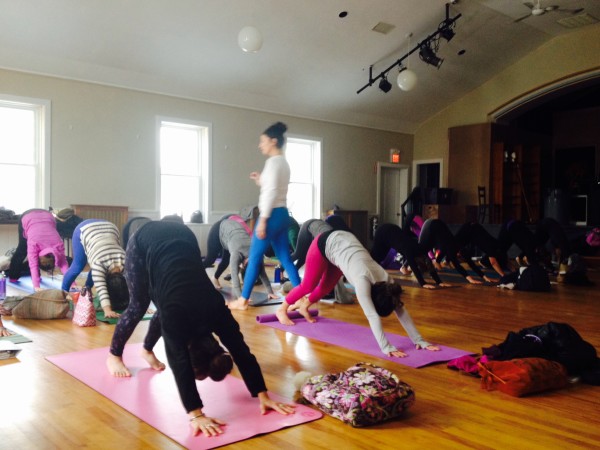
I absolutely love reading an article or taking a course, immersing myself in writing or reading about a particular subject and then bringing that concept into class from a teaching perspective. Right now, I’m writing my second book, which will be called “Structure and Spirit.” It focuses on several anatomical themes in the first 8 or so chapters and then has a second section which is more focused on different aspects of the human spirit. Â There are many days when I write for most of the day and then go into the studio to teach and it’s so wonderful to have real, live students to work with to bring the concepts I’ve written about all day come to life!
When I’m getting ready to teach a class based on a particular theme, I have an approach that I use that’s pretty much engrained in my head so I don’t need to write it down. But I thought it might be helpful to write it down, to try to operationalize the process. I’m a big “process” person and always try to get organized around things so they’re easily replicated.
Once I select a theme, let’s say, “Movements of the Shoulders,” I think about the muscles that are involved. So for the shoulders, I might focus on the Serratus Anterior, the Trapezius, the Deltoid, the 4 muscles of the Rotator Cuff and related muscles like the Pectoralis Major and Minor.
I then think about actions that the shoulders do, which might include anatomical movements like elevation, depression, retraction (drawing the shoulder blades in towards the spine) protraction (moving the shoulder blades further away from the spine) and then the related movements of internal and external rotation.
I then think about “non-poses” or regular movements I can have students perform that will contract and stretch the involved muscles in a repetitive way. So, for instance, I might start out the class with students laying on their back. I might have them move their arms in a “snow angel” type action, then make cactus arms, then have them take “eagle arms,” all while on the back. Once I started to really focus on the anatomy in my classes, I found this freedom to create movements and actions for students “outside of” the actual poses, which I saw as wonderful of course, but sometimes I wanted to warm up a particular part of the body and the poses in and of themselves just didn’t do it as well. I also wanted to have the ability to have students experience a certain action and the repetitive nature of movement in general might help them understand this action more.
Before I start the class, I share with them what the theme is for that class. I might demonstrate an anatomical action or actions we will be focusing on in that particular class. I might have a student demonstrate something and speak to what’s happening in the shape. I always try to keep these talks really short and focused (which is hard for me to do!) Once they’re in the first pose or shape, I shut up for a few minutes so they can let what they just heard sink in. I also want to give them a chance to just rest.
At this point, Â I’ve determined how I want to start the class so that at least gets the sequence going. I then keep the anatomical theme in the back of my mind as I’m teaching, and pepper the sequence with variations and poses that will reinforce the theme. Along the way, I share why I’m asking them to do what they’re doing, connect it back to the theme I shared at the beginning of class and share the muscles involved. Â I also like to share muscles that work on opposing actions; so, I might have them do “Cactus Arms” or interlace their fingers behind their back and talk about the Rhomboids creating this action and how it in turn, stretches the Pectoralis Major and Minor, the muscles that cause you to internally rotate at the shoulder joint. I might have them do Crow and Serratus Push Ups and Dolphin and refer to the action of the Serratus in all 3 poses.
Throughout, I look for spaces when I can stop talking and just let them be in silence. This is a very important thing to keep in mind when you teach with an anatomical focus because you don’t want to overwhelm people. You also want to leave space for them to figure things out on their own; to experience the practice in silence and to just be as they are.
It’s always great when someone comes up afterwards and says, “Hey, that was just what I needed! My shoulders feel great!” It’s not why we teach, but it’s always nice to know that you helped someone on their path to wellness.
How about you? Do you like to teach with anatomical themes in mind? I’d love to hear what themes you use.
If you like anatomical themes, check out my latest online course. It’s got 3 practices with 3 different anatomical themes, has an anatomy lecture with each sequence, the sequence notes, an muscle images. You can check it out here:
Learn the Anatomy, Practice It, Teach it
